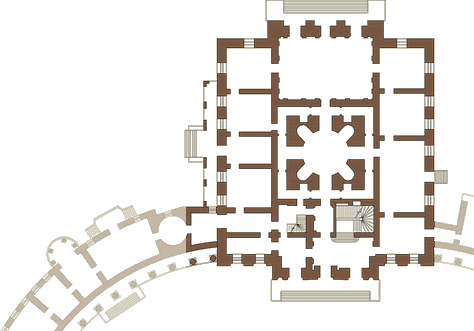The New Study
Загрузка панорамы...
In the 1780s, there was a bedchamber decorated by Charles Cameron. Its walls were upholstered in silk, and a bed stood opposite the windows. In 1800, architect Giacomo Quarenghi was commissioned to convert the bedroom into the study of Emperor Paul I. Hence its name, while the Raspberry Study became known as the Old Study. The walls of the Study are divided into panels lined with artificial marble. In the center of each wall, there are mirrors framed by Arabesque garlands painted in oil on marble. On the sides of the mirror on the central wall, Quarenghi constructed two consoles holding vases of colored stone.
However, in 1858, architect Ivan Potolov made some changes, while moving the study of Grand Duchess Alexandra Iosifovna here. The window slopes were trimmed to improve the lighting. The consoles were removed from the central wall and replaced by eight colored engravings brought by Grand Duke Pavel Petrovich from the famous trip to Europe in 1781-1782. They are made by the 18th-century Italian artist Giovanni Volpato, copying the famous frescoes of the Raphael Rooms in the Vatican. Currently, for their preservation, they remain in the museum holdings, replaced by facsimile copies in the exhibition. From top to bottom, right side: The Deliverance of Saint Peter, The Mass at Bolsena, The Fire in the Borgo, and The School of Athens. From top to bottom, left side: The Parnassus, The Meeting of Leo the Great and Attila, The Expulsion of Heliodorus from the Temple, and The Disputation of the Holy Sacrament.
In the space of the Study, there are two excellent examples of study furniture made in the workshop of the famous German furniture maker David Roentgen (the 1780s). In the center of the office, there is a lectern desk: an example of transforming furniture, very popular at the time. The opened lectern could be used to browse drawings, plans, and large albums with engravings. On the table, there is a bronze writing set: inkwell mortars, sandpit mortars, and candlestick cannons. It is a copy of the famous Chesma writing set of Catherine II (France, 1770s, based on the model of sculptor Jean-Antoine Houdon). To the left, against the wall, there is a cylindrical bureau, an indispensable object for business activities; it served not only as a desk but also as an escritoire with many secret and hidden drawers for documents. On the upper platform, there is a decorative porcelain sculpture of Apostle St. John (Meissen porcelain manufactory, the 18th century). An inscription in golden letters on a white plinth states that the sculpture was inspired by a painting by Pompeo Battoni. St. Mary Magdalene, its pair sculpture, is located on a bureau in the Raspberry Study.
Along the central wall, there is a mahogany set of Russian work of the 18th–early 19th centuries, and near the bureau, there is an unusual chair with oriental motifs (China (?), the late 19th–early 20th centuries).
A marble fireplace is an integral part of the decor of the Study. On the mantelpiece is one of the most interesting French clocks from the historical collection of the palace: Erigone Consumed by Love (workshop of Pierre-Philippe Thomire, clockmaker Louis-Jean Laguesse, the 1790s). Paul I purchased this clock for the St. Michael's Castle; after his death, it was moved to the Pavlovsk Palace and placed in the New Study. In the corners of the study, there are French Empire-style candelabra made of gilded and patinated bronze.
There is a set of three decorative vases (Ludwigsburg Porcelain Manufactory) on the pillar between the windows, on the elegant console. It was a gift to the Grand Duchess Maria Feodorovna from her uncle Charles Eugene, Duke of Württemberg, who requested the creation of the manufactory to give his court a royal shine. Miniature portraits of Pavel Petrovich and Maria Feodorovna are depicted in oval medallions on the body of the central vase, and portraits of the duke and his wife are depicted on two paired vases. The interior of the Study is completed by a gilded bronze chandelier with blue glass and crystal decor of Russian work, the late 18th century.
The New Study on the floor plane
- The Raspberry Study
- The Common Study
- The New Study
- The Corner Drawing Room
- The White Dining Room
- The Billiards Room
- The Old Drawing Room
- The Ball Room
- The French Room
- The Dark Pantry

Back
